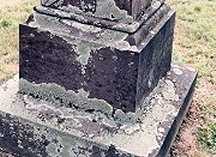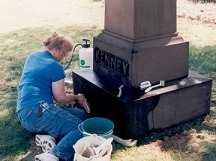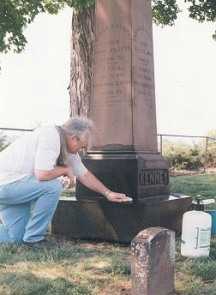“Enough with the wire brushes! Do you clean your teeth with a wire brush? Bleach? No!”
 Wire brushes, metal instruments and abrasive pads may give you instant satisfaction but, if you clean with anything that is harder than the stone, you risk scratching the face of the stone and causing more damage in the long run. The same goes for acidic cleaners, which includes most household cleaners. Powerwashers are also NOT recommended. Anything that puts out greater than 60 psi is too much force to use on older fragile stones. A garden hose putting out a gentle soaking spray is enough to clean and flush the stone (garden type sprayers also work well). If you’re talking about stones from the 20th century and not marble, that’s a different story.
Wire brushes, metal instruments and abrasive pads may give you instant satisfaction but, if you clean with anything that is harder than the stone, you risk scratching the face of the stone and causing more damage in the long run. The same goes for acidic cleaners, which includes most household cleaners. Powerwashers are also NOT recommended. Anything that puts out greater than 60 psi is too much force to use on older fragile stones. A garden hose putting out a gentle soaking spray is enough to clean and flush the stone (garden type sprayers also work well). If you’re talking about stones from the 20th century and not marble, that’s a different story.

Before and after examples and
what NOT to do to clean gravestones!
Cleaning a gravestone

Stones are composed of minerals and salts. Adding chemicals to them can often cause chemical reactions that will erode the stone faster than if you just left it alone. This damage is not immediately evident, as in the case with bleach being used on marble. The stone is exposed on all sides to the elements. Using bleach will not only give you instant brightness but will cause the stone to change in pallor and most often become rough to the touch. This is because the sodium chloride in the bleach has dissolved the binding minerals and caused the quartz crystals to start to exfoliate. When this process is used on particularly soft marble and limestone, the lettering is the first to disappear. Something that is over 100 years old shouldn’t look bright and new..!
For an excellent list of cleaning materials go to AGS http://www.gravestonestudies.org and look for Cleaning Gravestones in the Frequently Asked Questions section.
Remember, with all due respect to our monument dealers, many do not understand the concerns we have about OLD stones. They are mostly familiar with the dense granites that has been used for the past century. The techniques they use for modern stone is not safe for these fragile 200 yr.+ old markers. Each stone needs it’s own diagnosis; what is good in one situation is not necessarily good for all.
CGN recommends that you use the following low tech method and consult with us or professionals before using other methods. For marble, limestone and sandstone, use water and soft bristle brushes, natural or nylon. Granted it doesn’t sound like a miracle cleaner and it doesn’t happen quickly but with some patience and time this will clean most environmental soiling and lichens from stones. Keep the stone wet at all times; really wet. Where a garden hose is not available, be sure to bring plenty of jugs of water and keep dowsing the stone as you work and, most importantly, flush the stone well when done. Scrub the stone from the bottom up to avoid streaking and further staining. Household ammonia can be used if one can stand the aroma, but again be sure you flush the stone completely, more than one or two times, when you are done. Use a mix as you would for household cleaning, about 1 cup to a gallon of water. Don’t buy ammonia with anything extra in it, such as scents and suds. Wearing proper eye protection is also a must.
If lichen is a problem, you can soak it down with water and scrape with a wooden or plastic scraper. Tongue blades or craft sticks and inexpensive plastic putty scrapers from home stores work well. Remember, no metal. There are also poulticing techniques that can be used to soften lichen. Many lichens will, once removed, leave a scaring affect on the stone because the waste product they give off is an acid that works with the stone’s own salts and chemistry to erode it or bleach out some of its mineral component.